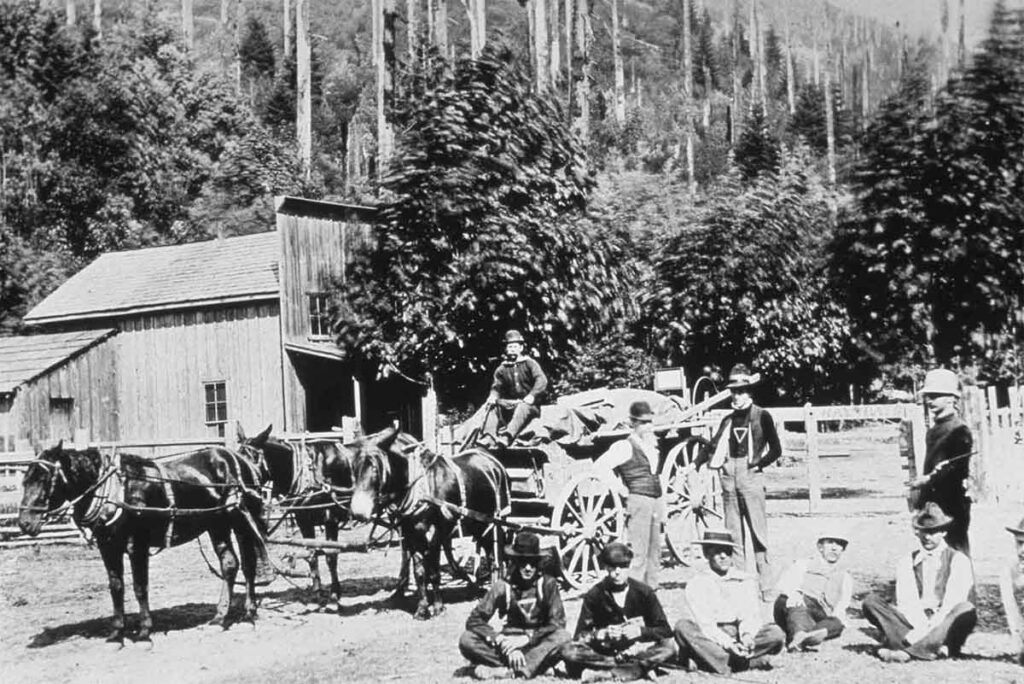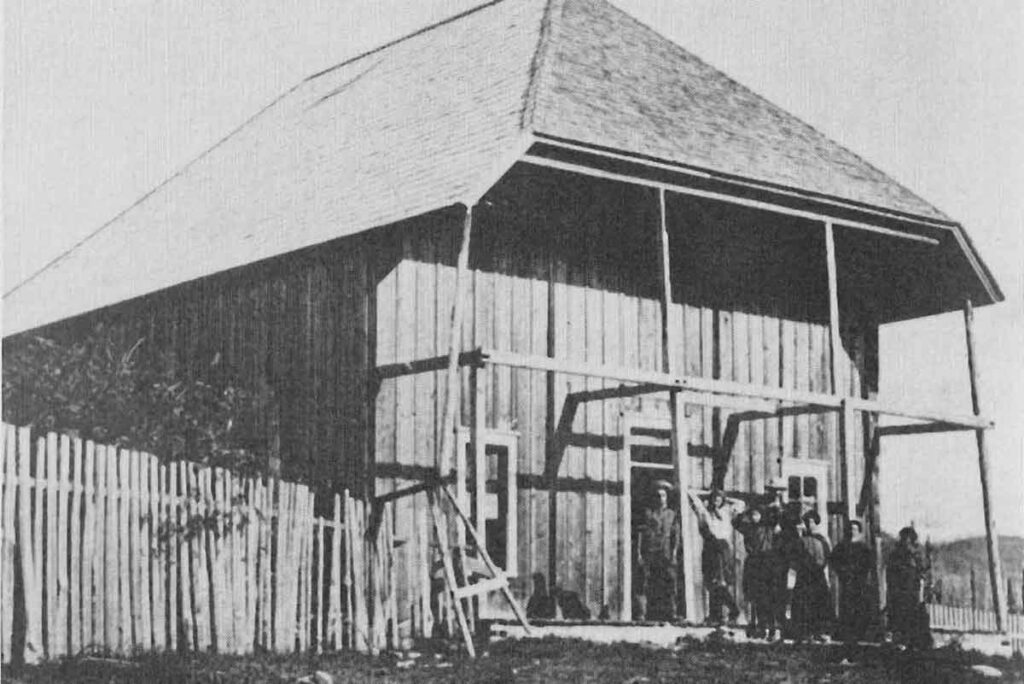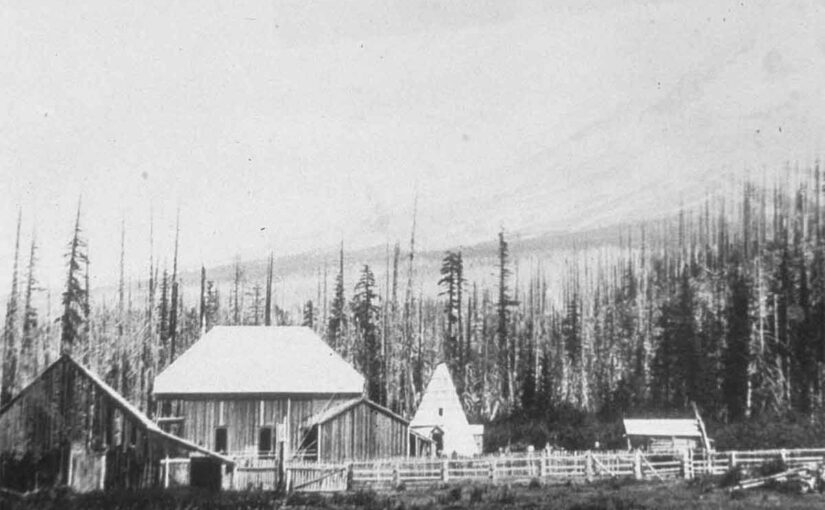A Crime in Oregon’s Cascade Mountains
A Dark Chapter From The Barlow Trail
When people think of Mount Hood, crime usually isn’t the first thing that comes to mind. Especially not murder. Yet, one story from Mount Hood’s past should be told—the mountain’s first recorded murder. This is the story of the first Murder on Mount Hood.
The Oregon Trail and the Barlow Road
For about 40 years, the Oregon Trail carried settlers west, and became the main route into the Willamette Valley. Samuel Barlow and Joel Palmer blazed the trail over the south shoulder of Mount Hood. Soon after Barlow made the trail a toll road. Tollgates were placed along the route to collect fees from travelers. One tollgate keeper, Perry Vickers, became an integral figure in the history of Mount Hood.
Perry Vickers: A Mount Hood Pioneer
Perry Vickers was among the first residents on the south side of Mount Hood, an area that today includes the small ski town of Government Camp. He was well liked by everyone, especially those passing over the Barlow Road in their wagons.
He secured squatter’s rights at Summit Meadow, a natural clearing at the top of the pass, in 1865. Here, the road began its descent down the west slope of Mount Hood, leading settlers on the final stretch toward the Willamette Valley. Vickers built the first accommodations in the area, including a lodge, store, barns, and a corralled field for livestock.
Mount Hood’s First Tourists
During his time on Mount Hood, Portland grew rapidly with the influx of new settlers. Many of these settlers returned to the mountain, over the road that had once challenged their or their parent’s journey, seeking recreation and adventure.
Vickers became Mount Hood’s first climbing guide. Hiking and climbing the peak became increasingly popular at the end of the 19th and early 20th centuries. He enthusiastically promoted visitation and recreation. Vickers even created a tradition of lighting the mountain by carrying fuel for a large fire near what is now known as Illumination Rock. He is credited with being the first person to spend a night atop Mount Hood.
In August 1873, Vickers survived a night on the summit by building a crude rock shelter. Later, he recalled, “I dared not sleep, lest the cold take me. At dawn, I beheld a glory of light such as mortal eyes rarely see.”
Perry Vickers’ Early Troubles
Vickers was known as a dreamer and a poet. Newspapers later referred to him as “the mountain’s first true romantic.” The Oregon Historical Society preserves some of his verses about sunrises over the Cascade peaks and sunsets glowing across the summit.
However, his start in Oregon wasn’t on solid footing.
In 1865, Vickers arrived in Vancouver, Washington. While looking for work, he fell in with three other young strangers. Unfortunately, they were soon arrested at Fort Vancouver for horse theft, a serious crime at the time.
They were held for about two months awaiting trial. Each prisoner wore an “Oregon Boot,” a seven-pound iron clevis attached to the ankle to prevent escape. Public sympathy grew for Vickers, who consistently protested his innocence.

Escape Across the Columbia River
Worried that guilt by association would seal his fate, Vickers planned an escape. Their wooden cell allowed them to pry loose several 2″x4″ window bars, and the group fled into the night.
Once free, Vickers separated from his companions. Pursuers closed in as he reached the Columbia River. His ankle was chafed and bleeding from the iron shackle. In desperation, he plunged into the mile-wide, fast-moving river.
Miraculously, he swam across with the seven-pound clevis still attached to his ankle.
On the far bank, Vickers found a farm where he pried off the iron using a wagon wheel wrench and a bolt. The next morning, woodcutters gave him food and directed him to Powell Valley, where his brother lived. His brother provided clothes and supplies and urged him to head east along the Barlow Road to find work until the danger passed.
Meeting Stephen Coalman
Traveling east, Vickers met Stephen Coalman, the overseer of the old Barlow Road. Coalman offered him work clearing storm damage from the road, and Vickers accepted. The two men formed a lifelong friendship.
Stephen and his son Elijah “Lige” Coalman would later become legendary for their adventures on Mount Hood. Over time, Coalman became convinced of Vickers’ innocence.
In June, Vickers set up camp at Summit Meadow and explored the area up to the timberline. He swore he would one day reach the mountain’s summit.

Establishing Life at Summit Meadow
At first, Vickers worked as the eastern gatekeeper on the Barlow Road. In time, Coalman convinced him to return to the west side of Mount Hood, promising to help him with legal services if needed.
No charges were ever brought against him.
Vickers loved the Summit Meadow area. He filed a squatter’s claim and started building between his work on the road. In 1866, construction of the Summit House began. The building measured 20x20x32 feet, featuring a huge fireplace, upstairs sleeping quarters, and a large kitchen. Vickers built all the furniture by hand from local materials.
By the spring of 1868, as soon as the snow melted, the Summit House opened for travelers. Vickers provided food and shelter for people and livestock. He often refused payment from settlers who had little to give, earning a reputation for generosity.
A Tragedy at Summit Meadow
In 1882, a tragedy struck Summit Meadow. A baby boy from a wagon party, the Barclay family, became ill and died at the meadow. Vickers granted permission for the boy to be buried there. The grave and headstone still remain today.
Later accounts said that Vickers personally tended the grave, keeping it marked and protected from passing livestock.

A Desperate Man on The Run
For years, Vickers remained at Summit Meadow, aiding travelers and leading hundreds to the summit of Mount Hood. Then, in August of 1883, violence shattered the peace and led to the first Murder on Mount Hood.
A man named Steele, a farmhand near the Columbia Slough, stole a shotgun and fled east. The Multnomah County Sheriff deputized two men, including the gun’s owner, Roarke, to pursue him.
The deputies tracked Steele to Eagle Creek and had their warrant reissued for Clackamas County. They learned that Steele had traded the shotgun for a powerful Sharps rifle.
Despite bad weather, they pressed on through Sandy, stopping only to buy a bottle of whiskey. Reaching the town of Salmon, near today’s Brightwood, they enlisted local trading post owner John McIntyre. One deputy, having fallen ill, returned home. McIntyre was deputized, and the search continued.
The Final Pursuit
At Summit Meadow, Vickers told the men that Steele had stayed the previous night. Vickers warned them that Steele was a dangerous character and advised waiting until morning to pursue him, suggesting they rest and sober up.
Roarke insisted they continue into the night. Vickers, now deputized, reluctantly agreed to lead them.
They reached the White River Trading Post operated by Cornelius Gray. Beyond the buildings, they spotted a campfire.
Concerned about his companions’ condition, Vickers volunteered to approach Steele’s camp alone. As he rode off, he reportedly quipped, “If you hear me shout, don’t mistake it for the wind.”
The Ambush
Vickers rode toward the fire, confirming it was indeed Steele. As he dismounted his horse, Steele seized the Sharps rifle and shot Vickers in the stomach.
Vickers fell but managed to draw his revolver and fire into the darkness. Believing he might have wounded Steele, he emptied his gun but could not stop the fugitive.
Cornelius Gray, hearing the shots, rushed to the scene. He and others found Vickers gravely wounded, struggling to reload his revolver with trembling hands.
Vickers accused the deputies, Roarke and McIntyre, of cowardice, saying they abandoned him when he needed them most. Witnesses later agreed, noting that their horses had not actually bolted, and their retreat seemed deliberate.
The Death of Perry Vickers
A messenger rode to fetch Stephen Coalman, but it was too late. Vickers, lying inside Gray’s cabin, knew his fate.
He mentioned laudanum stored back at his lodge. Gray had nothing in his cabin to relive Vickers’s pain. Vickers acknowledged that no one could help him now. His final request was to be buried next to the Baby Barclay that he helped bury in his beloved Summit Meadow. His final words were reported as, “Tell them I did my best, for the mountain and for the law.”
At 7am, August 19, 1883 Perry Vickers died from his wounds. According to his wishes his body was loaded into a wagon and carried back to Summit Meadow and buried next to the baby.
The Aftermath and Legacy
The Mount Hood community mourned him deeply. Samuel Welch and Stephen Mitchell crafted his coffin, and Oliver Yocum officiated his burial.
Vickers is laid to rest at Summit Meadow, beside the Barclay child he had once shown such compassion toward. Their headstones remain today.
Locals remembered Vickers as “the silent sentinel of Summit Meadow,” honoring his years of guidance, kindness, and service on the mountain.
Soon after Vickers death a “religious eccentric” named Horace Campbell, known as “King David” occupied the Summit House. He rebuilt the Summit House and, behind the structure, constructed a conical shaped wooden teepee with a central fireplace and a smoke hole at the top. It was used by the last wave of immigrants over the old road.
In time, and after many occupiers of the old Summit House, the structure was fell into disrepair and was disassembled and burned on campfires by travelers. First the log furniture and then the structures. Today there’s no evidence that it even existed.
Perry Vickers’s Dog Greeley
Billy Welch, The son of local rancher Samuel Welch, related a sad story about how Greeley, a yellow Newfoundland and Eskimo dog mix owned by Vickers, refused to leave his master’s grave for days. Finally he and Drum, a spotted hound, also belonging to Vickers, were brought to Welches to live with Samuel Welch, who had been a close friend with Vickers for years. It was necessary to keep a close watch on Greeley for days, because he wanted to return up the Barlow Trail to Summit Meadow where is master was buried.

What Became of Steele After the Murder on Mount Hood?
Stephen Coalman kept Vickers’ blood-stained coveralls for years, hoping they might someday serve as evidence.
Later, a horse thief hanged in eastern Oregon claimed to have killed a man in the Cascade Mountains. It was widely assumed this was Steele.
Coalman, realizing the case had ended, eventually burned Vickers’ coveralls. Thus ended the story of Mount Hood’s first murder—and the enduring legend of Perry Vickers.
Sources Consulted
- Weekly Oregon Statesman, February 22, 1864
- The Oregonian, March 17, 1864
- The Oregonian, August 25, 1873
- The Oregonian, August 20, 1883
- The Oregonian, August 21, 1883
- Corvallis Gazette Times, December 14, 1883
- The Oregonian, August 15, 1885
- Albany Daily Democrat, July 13, 1888
- The Oregon Daily Journal, November 10, 1929
- The Story of Lige Coalman by Victor H. White
- Wy’east “THE Mountain” by Fred McNeil.
- Mount Hood: A Complete History by Jack Grauer


Gary, where are the graves located? We would love to check it out when the snow melts! My ancestors traveled the Oregon Trail and helped settle Gresham, so I find Barlow Trail history fascinating. Thanks!
Chris & Clover Clausen
Hello Clover Clausen.
The graves are located at Summit Meadow. There’s a small cemetery there. If you drive through Still Creek Campground to Summit Meadow you can’t miss them.
Or you can just travel up hwy 26 to trillium lake turn at the first right hand turn as you turn onto trillium lake road its not a paved road but goes past a free primative camp area and just keep following the dirt road around a small bend where the rental houses start . the first house on you’re left , it has a small rickity fenced area around a tree in front. That was Vickers old house and where him and the baby were laid to rest. The graves are fenced in under the tree. Across the road from it is the medow where the look out is. On the left is a telephone pole that has a phone number to call that also has a four or 5 didgit number to type in and the story begins to tell you that areas history. Complete with Vickers narrative or someone’s voice playing Vickers hself telling you the whole story. Very neat thing someone created. There at various other places like this all around Oregon . People should check it out!
Sincerely
,
Brenda Davis
Or you can just travel up hwy 26 to trillium lake turn at the first right hand turn as you turn onto trillium lake road its not a paved road but goes past a free primitive camp area and just keep following the dirt road around a small bend where the rental houses start . the first house on you’re left , it has a small rickety fenced area around a tree in front. That was Vickers old house and where him and the baby were laid to rest. The graves are fenced in under the tree. Across the road from it is the medow where the look out is. On the left is a telephone pole that has a phone number to call that also has a four or 5 didgit number to type in and the story begins to tell you that areas history. Complete with Vickers narrative or someone’s voice playing Vickers himself telling you the whole story. Very neat thing someone created. There at various other places like this all around Oregon . People should check it out!
Sincerely
,
Brenda Davis
Enjoyed reading this story. Thank you.
very interesting! thanks for posting..
A great piece however the wording suggesting Vickers was the first person to spend a night on the top of Mt Hood should be corrected. He was the first know Euro American to summit Mt Hood.
**first know Euro American to spend a night on the top of Mt Hood. Not summit.
I should have said that he was the first documented person to spend the night there. It should also be noted that he was not the first to climb the mountain. He was the first to camp out up there.
I discussed this once, light heatedly, with a native friend of mine. He told me that he’s not convinced that there was a reason for a native to climb the mountain. His argument was that in those days everything had a utilitarian purpose or reason. He couldn’t imagine a purpose to climb it beyond recreation.
I would like to think that there was at least one native who took on the challenge just for the challenge. 🙂
Thank you Sara.
Gary; great article, with more information about the murder of Perry Vickers than I have ever seen before! I am curious, what were your source(s)? I work as an archaeologist for the Forest Service, and have been doing some research and investigation in what I believe is the exact location for Grays store. Your article mentions “buildings” as in plural. If you can provide me with the citation it would be much appreciated!! Mike.
Hello Mike.
Thank you for contacting me.
I have been collecting history of the Mount Hood and the Columbia Gorge, primarily books and photographs, since I was a teenager. I’m 58 years old now. Many of the local history books are out of print.
The sources for the information on the Perry Vickers article were the Victor White book about Lige Coalman, Jack Grauer’s Mount Hood, A Complete History book as well as Fred McNeil’s book, Wy’east THE Mountain. Clackamas County/ Wasco County Historical Society’s Barlow Road book.
It’s likely that Gray’s Store had more than one building. A barn/stable or an outbuilding(s) for travelers, at the least, would be likely, but I have no firm information beyond the plural “buildings” when the place is mentioned in Victor White’s book. Because White River area is so dynamic much of the area is different than it was back then. I have heard that the original structure/structures there burned. The White River Gift Shop that was located there in the beginning of this century was taken out by a flood, or so is my understanding. I can’t prove either.
I hope that this helps. Let me know if you need any more info.
Thanks again Mike.
Gary
Thank you Gary! What a great story… I own a small cabin on Perry Vickers Road. My grandparents bought it in the late 1940’s. My great great grandparents were associated with SWIM. My great great great grandfather is Daniel Parker, tollgate operator near Rhododendron. Thanks for the Summit Meadows history lesson….
Hi Kerri. Thank you for the note. There’s a lot of Mount Hood history in your family. 🙂 Do you have any old photos or stories to share?